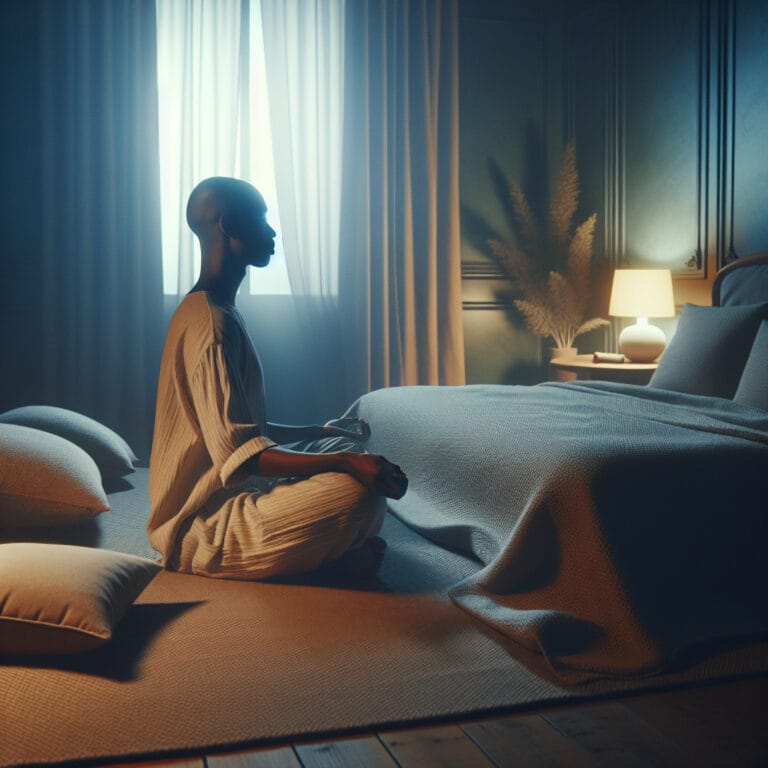
Drift into Dreamland: Using Progressive Muscle Relaxation for Better Sleep
Table of Contents
- Introduction
- Understanding Progressive Muscle Relaxation
- The Connection Between PMR and Sleep
- Implementing PMR into Your Nightly Routine
- Additional Tips for Better Sleep
- Conclusion
- Frequently Asked Questions
Introduction
Progressive Muscle Relaxation (PMR) is a relaxation method that has garnered significant attention for its ability to enhance sleep quality. This deep relaxation technique involves tensing and then slowly releasing each muscle group, promoting a state of tranquility that can ease the transition into slumber. It’s not merely an anecdotal remedy; a study found that participants who engaged in PMR experienced a marked decrease in sleep problems, affirming its efficacy as a scientifically backed relaxation response.
Quality sleep is the cornerstone of good health, impacting everything from mental clarity to physical resilience. With stress and anxiety often being major culprits behind restless nights, PMR serves as an invaluable tool in reducing anxiety and relieving tension. By deliberately focusing on each muscle group—beginning with the calf muscles and progressing upward—individuals can distract their minds from the intense pain or stressors of the day.
The beauty of this relaxation exercise lies in its versatility: it can be practiced with eyes open or closed, accompanied by deep breaths to further induce calmness. For those struggling with low back pain which interferes with restful sleep, or looking to relieve dental anxiety before bedtime routines, engaging in these progressive muscle relaxation exercises can offer tangible relief.
Adopting PMR doesn’t just treat anxiety—it fosters long-term improvements in one’s approach to mental health and well-being. Through repeated practice, this relaxation technique trains the body’s relaxation response to activate more readily—a boon for individuals seeking sustainable strategies to fall asleep faster and remain asleep longer.
Incorporating this valuable relaxation method into nightly rituals could be transformative for many suffering from inadequate rest. By learning how to tightly contract then release muscles systematically through guided progressive muscle relaxation deep breathing techniques, even those plagued by significant stress may find solace—and much-needed sleep—at last.
Understanding Progressive Muscle Relaxation
The historical roots of Progressive Muscle Relaxation (PMR) trace back to the early 20th century, developed by Dr. Edmund Jacobson, who proposed that since muscle tension accompanies anxiety, one can reduce anxiety by learning how to relax muscular tension. This foundational principle has evolved into a relaxation method widely practiced for enhancing sleep quality and reducing anxiety. The scientific underpinning of PMR lies in its ability to induce the relaxation response—a physiological state opposite to stress activation where heart rate slows, blood pressure decreases, and breathing deepens—thereby setting the stage for better restorative sleep.
To experience the full benefit of progressive muscle relaxation exercises on sleep quality, one should follow a consistent routine that involves tensing each major muscle group with deliberate muscle tensing before slowly releasing it. Here’s a focused guide on practicing this effective relaxation technique:
– Begin in a comfortable position, either lying down or seated in an area conducive to tranquility.
– Dedicate a moment to engage in some deep breaths, easing your mind away from daily stressors.
– Start focusing on your lower extremities; tightly contract your calf muscles as you inhale deeply for about five seconds.
– As you exhale smoothly, release the tension you’ve built up entirely—visualize the stress flowing out with every slow breath.
– Progressively move through other key muscle groups: thighs, buttocks, abdomen, chest muscles; give attention and care to each section.
– Include upper body regions like shoulders (where tension often accumulates), arms down to clenched fists—even facial muscles aren’t exempt from gentle tensing and relaxing motions.
As these progressive muscle relaxation techniques are applied systematically from toes upward or vice versa—like waves receding back into an ocean—each successive contraction and release sequence disentangles knots of physical discomfort related to low back pain or intense pain elsewhere. Individuals utilizing PMR find their minds shifting away from racing thoughts—a reduction in mental chatter paving way for slumber’s embrace.
Moreover, those suffering from conditions such as dental anxiety may discover solace before bedtime routines through these rhythmic practices. The beauty of this technique is its universal applicability; whether eyes open during brief breaks at work or closed as part of pre-sleep rituals at home.
By recognizing that each deep breath plays cohesively within this orchestra of relaxing muscles—to relieve tension and ease stress—the process becomes more than just an exercise but rather a holistic approach towards nurturing mental health alongside sleep enhancement endeavors. A study found that sustained engagement with PMR not only promotes immediate calmness but also contributes significantly towards combating long-term sleep problems by ingraining healthier patterns conducive for restful nights ahead.
The Connection Between PMR and Sleep
Embarking on a journey toward restorative sleep, an expert viewpoint elucidates the way Progressive Muscle Relaxation (PMR) interacts with the nervous system to usher in a state of tranquility essential for high-quality slumber. This relaxation method is grounded in a physiological process where deliberate muscle tensing and slow release cycles activate the body’s natural relaxation response. When muscles are tightly contracted, then subsequently relaxed, signals are sent to the brain triggering a cascade that lowers stress hormones, effectively reducing anxiety and easing stress. By incorporating deep breathing into this relaxation technique, you can further enhance its calming effect—a harmonious blend of controlled breaths and purposeful muscle relaxation which together induce an ideal pre-sleep condition.
Research studies examining PMR’s role in sleep enhancement lend empirical weight to its efficacy; one study found participants who practiced progressive muscle relaxation exercises regularly reported a significant decrease in sleep problems. The implication of these findings points towards PMR as more than just another bedtime ritual—it emerges as a scientifically-supported approach for those grappling with disruptions in their nocturnal rest due to stress or anxiety. The beauty lies not only in its simplicity but also its power to transform bedtimes into gateways towards uninterrupted nights.
For individuals navigating their way through intense pain or mental unrest at nightfall, PMR provides a beacon of hope by allowing them to intentionally direct focus towards each muscle group—starting perhaps with the tension-prone calf muscles—and work upwards or downwards systematically. This practice serves multiple purposes: it draws attention away from pain points like low back pain or dental anxiety while simultaneously fostering a meditative state conducive for sleep onset.
As we delve deeper into understanding this connection between muscular manipulation and mental ease, it becomes clear why progressive muscle relaxation deep breathing techniques are gaining traction among those seeking holistic ways to treat anxiety and enhance mental health without solely relying on medication. Combined with consistency and patience, progressive muscle relaxation emerges not just as an exercise but as an all-encompassing route toward achieving better sleep quality night after night—evidence that our bodies inherently possess the tools needed for self-healing if guided correctly.
In summary, whether your eyes open during daylight hours or closed as you nestle under nighttime’s embrace—you have within your grasp through PMR—a profound means by which you can relieve tension across all muscle groups, reduce anxiety feel levels substantially and ultimately fall asleep into tranquil depths unburdened by life’s daily demands.
| Aspect | Description | Benefits |
|---|---|---|
| What is PMR? | Progressive Muscle Relaxation (PMR) is a technique that involves tensing and then relaxing muscle groups. | Induces a state of tranquility essential for high-quality sleep. |
| Physiological Process | Deliberate muscle tensing and slow release cycles activate the body’s natural relaxation response. | Lowers stress hormones, reduces anxiety, and eases stress. |
| Deep Breathing Integration | Incorporates deep breathing with muscle relaxation. | Enhances the calming effect, inducing an ideal pre-sleep condition. |
| Research Findings | Studies show regular PMR exercises lead to a significant decrease in sleep problems. | Scientifically-supported method for improving sleep quality. |
| PMR for Pain and Mental Unrest | Focuses attention on relaxing each muscle group, which can divert attention from pain and anxiety. | Provides relief from pain and mental unrest, fostering a meditative state conducive for sleep onset. |
| PMR in Mental Health | PMR deep breathing techniques are used as a holistic approach to treat anxiety and enhance mental health. | Offers a non-medicinal route towards achieving better sleep quality. |
| Summary | PMR is a self-guided technique for tension relief and anxiety reduction. | Helps to achieve tranquil sleep unburdened by life’s daily demands. |
Implementing PMR into Your Nightly Routine
A serene slumber is not a distant dream for those who practice Progressive Muscle Relaxation (PMR). This relaxation technique serves as a powerful ally in the quest for superior sleep quality, drawing upon deep breathing and deliberate muscle tensing to quiet the mind and prepare the body for rest. A study found that individuals who incorporate progressive muscle relaxation exercises into their nighttime routine experience a significant decrease in sleep problems, solidifying PMR’s role as an effective means to combat insomnia.
To integrate PMR effectively into pre-sleep rituals, create a peaceful environment free from distractions. Dim lighting can signal to your body that it’s time to wind down, while ensuring your bedroom is reserved primarily for sleep and relaxation reinforces its association with tranquility. Begin your routine by selecting a comfortable position—whether seated or lying down—and allow yourself several deep breaths to set the intention of calmness. As you focus on each muscle group, engage in the process of deliberately tensing muscles before slowly releasing them; this acts as a physical manifestation of letting go of the day’s stresses.
The calf muscles often hold tension after long hours of standing or sitting; by starting here—or any other preferred starting point—and working systematically through other areas of potential tightness such as shoulders or jawline, you encourage whole-body relaxation. This meticulous attention to individual muscle groups not only alleviates physical strain but also redirects mental focus away from anxiety-inducing thoughts.
Maintaining consistency with this method is key—just like mastering any skill requires regular practice. Set aside time each night for these exercises; even just ten minutes can profoundly impact your ability to fall asleep more effortlessly and enjoy deeper rest throughout the night. Embrace this quiet moment for yourself as an integral part of your daily self-care regimen.
Progressive Muscle Relaxation isn’t merely about reducing anxiety or relieving intense pain—it’s about nurturing overall mental health and fostering an internal sanctuary where stress dissolves effortlessly away at day’s end. By pairing progressive muscle relaxation deep breathing techniques with environmental adjustments conducive to restfulness, one sets the stage nightly for rejuvenating sleep that revitalizes both mind and body come morning light.
Remembering that every deep inhale paired with mindful muscle engagement guides you closer towards serenity—the repeated act transforms into second nature over time—a testament that our bodies have intrinsic capabilities toward achieving balance when provided with gentle guidance through practices like PMR.
Additional Tips for Better Sleep
Delving into the realm of restorative slumber, a study found that integrating Progressive Muscle Relaxation (PMR) into one’s nightly regimen not only enhances sleep quality but also acts as a cornerstone in the architecture of mental and physical well-being. This relaxation method, deeply rooted in scientific understanding, involves tensing and carefully releasing muscle groups in coordination with deep breathing techniques—a symphony of calm that orchestrates an ideal environment for the body to transition into restful states. PMR is more than just a series of relaxation exercises; it is an invitation to reacquaint oneself with the nuances of personal comfort and tranquility.
The efficacy of PMR is bolstered by its ability to evoke the body’s relaxation response—a counterbalance to the stress anxiety cycle—leading to a significant decrease in sleep problems. By engaging deliberately in this relaxation technique, individuals can alleviate intense pain from areas such as calf muscles or dissipate low back pain, all while redirecting focus away from daily pressures. More than a remedy for reducing anxiety or relieving dental anxiety before bed, progressive muscle relaxation exercises serve as preventive maintenance for mental health, continuous practice fine-tuning our innate capacity to relieve tension and treat anxiety without pharmaceutical intervention.
Complementary practices can further augment the benefits brought by PMR:
– Mindfulness meditation before bedtime creates mental space between you and your thoughts.
– A consistent sleep-wake schedule reinforces circadian rhythms conducive to deeper sleep.
– Dietary adjustments avoid stimulants like caffeine late at day which may disrupt natural sleep patterns.
– Creating an optimal sleeping environment—cool, darkened room free from electronic distractions—ensures external factors are primed for an uninterrupted night’s rest.
For those seeking holistic lifestyle changes beyond mere exercise routines, adopting habits like regular physical activity during daylight hours promotes fatigue at day’s end while avoiding long naps ensures sleep pressure builds appropriately towards nightfall. The interplay between these lifestyle alterations and systematic PMR sessions cumulatively elevates one’s overall quality of repose.
If persistent disturbances mar nocturnal serenity despite diligent application of progressive muscle relaxation deep breathing protocols alongside supportive lifestyle modifications—a consultation with healthcare professionals adept in sleep medicine could unveil underlying conditions requiring specialized care. Whether grappling with chronic insomnia or other complex disorders disrupting slumber’s embrace—it is essential not to downplay one’s struggle but rather seek out informed advice facilitating targeted interventions paving way toward nights filled once more with peace rather than perturbation.
Therein lies the comprehensive approach: weaving together advanced relaxation techniques like PMR with environmental tweaks and behavioral adjustments creates a tapestry rich enough to envelop any sleeper in warmth conducive for healing dreams—a testament that when armed correctly we hold power over our domain beyond waking hours; indeed even amidst elusive shadows cast by moonlit dreams.
| Strategy | Description | Benefits |
|---|---|---|
| Progressive Muscle Relaxation (PMR) | Tensing and releasing muscle groups in coordination with deep breathing. | Enhances sleep quality, mental and physical well-being, reduces pain and anxiety. |
| Mindfulness Meditation | Practicing meditation before bedtime to create mental space. | Reduces stress and anxiety, promotes relaxation. |
| Sleep-Wake Schedule | Maintaining a consistent time for sleeping and waking. | Reinforces circadian rhythms, conducive to deeper sleep. |
| Dietary Adjustments | Avoiding stimulants like caffeine in the late day. | Prevents disruptions in natural sleep patterns. |
| Sleeping Environment | Creating a cool, dark, and quiet space for sleep. | Minimizes interruptions for an uninterrupted night’s rest. |
| Physical Activity | Engaging in regular exercise during daylight hours. | Promotes evening fatigue and better sleep quality. |
| Avoiding Long Naps | Staying away from extended sleep periods during the day. | Ensures sufficient sleep pressure builds towards night. |
| Consult Healthcare Professionals | Seeking advice for persistent sleep disturbances. | Addresses underlying conditions, provides specialized care. |
Conclusion
Embrace the transformative power of Progressive Muscle Relaxation (PMR), a scientifically validated relaxation method that significantly amplifies sleep quality. This revered relaxation technique calms the mind and conditions the body for rest by involving tensing and slowly releasing muscle groups, from calf muscles to facial features. It’s not just about reducing anxiety; PMR intertwines deep breathing with deliberate muscle tensing, invoking a profound relaxation response. Studies consistently showcase PMR’s prowess in decreasing sleep problems through its unique ability to ease stress and relieve tension across all muscles. By incorporating progressive muscle relaxation exercises into your bedtime routine, you’re on a path to fall asleep faster and enjoy deeper slumber—turning restful nights from aspiration to reality. Witness as each deep breath ushers in tranquility, guiding you gently towards a restorative journey into night’s embrace.



